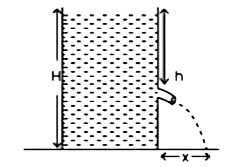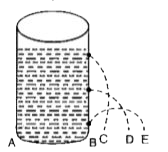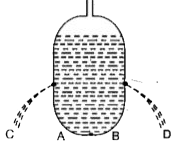Two tiny holes are made in a plastic bucket, one near the middle part and the other just above bottom.When this bucket is filled with water, the water rushes out from the bottom hole much faster than from the upper hole. What conclusion do you get from this observation ?
Step-by-Step Solution:
1. Understanding the Setup: We have a plastic bucket filled with water, and two holes are made: one hole is located near the middle of the bucket (let's call it Hole 1) and the other is just above the bottom (let's call it Hole 2).
2. Observation of Water Flow: When the bucket is filled with water, we observe that the water flows out of Hole 2 (the bottom hole) much faster than it flows out of Hole 1 (the middle hole).
3. Analyzing the Speed of Water Flow: We denote the speed of water flowing out of Hole 1 as V1 and the speed of water flowing out of Hole 2 as V2. From our observation, we can conclude that V2 > V1, meaning that the speed of water flowing from Hole 2 is greater than that from Hole 1.
4. Understanding Pressure and Force: The speed of the water flow is influenced by the pressure at each hole. The pressure at a certain depth in a fluid is given by the formula:
P=FA
where P is pressure, F is force, and A is the area of the hole. Since the area of both holes is constant, the force pushing the water out is directly related to the pressure at that depth.
5. Comparing Pressures at the Holes: Since V2 > V1, we can infer that the pressure at Hole 2 (P2) must be greater than the pressure at Hole 1 (P1). Therefore, we can write:
P2>P1
6. Relating Depth to Pressure: The pressure in a fluid increases with depth. Since Hole 2 is deeper than Hole 1, we can say that the depth at Hole 2 (h2) is greater than the depth at Hole 1 (h1):
h2>h1
This means that the pressure at Hole 2 is greater due to its greater depth.
7. Conclusion: From these observations and analyses, we conclude that pressure increases with depth in a fluid. This explains why the water flows out of Hole 2 faster than out of Hole 1: the greater pressure at the bottom hole results in a greater force pushing the water out, leading to a higher speed of flow.
P=FA
where P is pressure, F is force, and A is the area of the hole. Since the area of both holes is constant, the force pushing the water out is directly related to the pressure at that depth.
P2>P1
h2>h1
This means that the pressure at Hole 2 is greater due to its greater depth.
Topper's Solved these Questions
Similar Questions
An empty plastic bottle is kept and three holes are made in it at the same height from the bottom of the bottle. Bottle is now filled with water. Water stands leaking out 'from the holes. Do the different stream of water coming out of the holes fall at the same distance from the bottle? What conclusion do you draw ?

View SolutionA closed vessel is half filled with water. There is a hole near the top of vessel and air is pumped out from this hole.
View Solution
Knowledge Check
There is a hole h metre from its top of a tank filled with water. Calculate the distance x where the stream of water will touch the ground from the bottom (in m).
 A2√h(H−h)B2√g(H−h)C√2hHD√2gH
A2√h(H−h)B2√g(H−h)C√2hHD√2gHA large open tank has two holes in the wall. One is a square hole of side L at a depth y from the top and the other is a circular hole of radius R at a depth 4y from the top. When the tank is completely filled with water, the quantities of water flowing out per second from both holes are the same. Then, R is equal to
AL√2πB2πLCL√2πDL2πA large open tank has two holes in the wall. One is a square hole of side L at a depth y from the top and the other is a circular hole of radius R at a depth 4y from the top. When the tank is completely filled with water, the quantities of water flowing out per second from both holes are the same. Then, R is equal to
A(a) L√2πB(b) 2πLC(c) LD(d) L2π
Three tiny holes are made in an empty can at different levels, one over the other.

They are temporarily closed with an adhesive tap and then the can is filled with water. As the tapes are pulled out, water starts flowing out from the holes. It is observed that water flowing out from the lowest hole goes farthest and that from the uppermost hole nearest to the can (BE > BD > BC). Why? What does this experiment show ?
View SolutionWhen magnesium is burned in air, a powdery ash X is formed. X on dissolving in water forms Y.
What conclusion do you get about the nature of Y from its action on litmus paper ?
View SolutionWhat will happen if you make two tiny holes of the same size at equal heights from the bottom in a plastic bottle filled with water? What does this experiment prove?

View SolutionThere is a small hole at the bottom of tank filled with water. If total pressure at the bottom is 3atm(1atm=105Nm−2), then find the velocity of water flowing from hole.
View SolutionA large open tank has two holes in the wall. One is a square hole of side L at a depth h from the top and the other is a circular hole of radius r at a depth 4h from the top. Whwn the tank is completely filled with water, the quantity of water flowing out per second from both the holes are the same. What is the value of r?
View Solution
